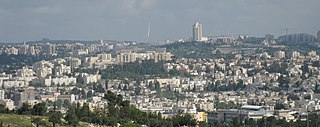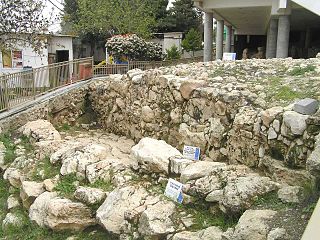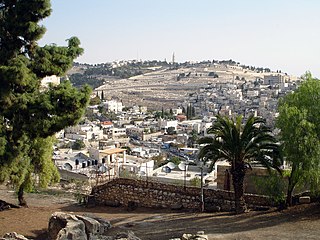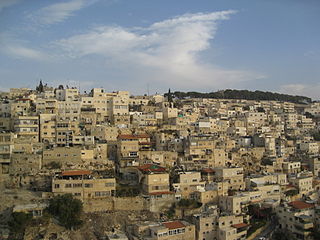
Jerusalem is a city in Western Asia. Situated on a plateau in the Judaean Mountains between the Mediterranean and the Dead Sea, it is one of the oldest cities in the world, and is considered holy for the three major Abrahamic religions: Judaism, Christianity, and Islam. The city straddles the Green Line between Israel and the West Bank; both Israelis and Palestinians claim Jerusalem as their capital. Israel controls the entire city and maintains its primary governmental institutions there while the Palestinian National Authority and Palestine Liberation Organization ultimately foresee it as the seat of power for the State of Palestine. Due to this long-running dispute, neither claim is widely recognized internationally.

The City of David is the name given to an archaeological site on the southeast hill of contemporary East Jerusalem, which is thought to constitute the original settlement core of Jerusalem during the Bronze Age and Iron Ages.

The Old City is a 0.9-square-kilometre (0.35 sq mi) walled area in East Jerusalem, part of the territory considered to be occupied by Israel by the international community.

During its long history, Jerusalem has been attacked 52 times, captured and recaptured 44 times, besieged 23 times, and destroyed twice. The oldest part of the city was settled in the 4th millennium BCE, making Jerusalem one of the oldest cities in the world.
Ir Amim(Hebrew: עיר עמים; "City of Peoples" or "City of Nations") is an Israeli activist non-profit founded in 2004 that focuses on the Israeli-Palestinian conflict in Jerusalem. It seeks to ensure the "dignity and welfare of all its residents and that safeguards their holy places, as well as their historical and cultural heritages."

Tel Rumeida, also known as Jabla al-Rahama and referred to by Israeli settlers as Tel Hebron is an archaeological, agricultural and residential area in the West Bank city of Hebron. Within it, lies a tell whose remains go back to the Chalcolithic period, and is thought to constitute the Canaanite, Israelite and Edomite settlements of Hebron mentioned in the Hebrew Bible.

Silwan or Siloam is a predominantly Palestinian neighborhood in East Jerusalem, on the outskirts of the Old City of Jerusalem.

Ophel, also Graecised to ophlas, is the biblical term given to a certain part of a settlement or city that is elevated from its surroundings, and probably means fortified hill or risen area. In the Hebrew Bible, the term is used in reference to two cities: Jerusalem, as in the Book of Chronicles and Book of Nehemiah, and Samaria, mentioned in the Books of Kings. The Mesha Stele, written in Moabite, a Canaanite language closely related to Biblical Hebrew, is the only extra-biblical source using the word, also in connection to a fortified place.

Judaization of Jerusalem is the view that Israel has sought to transform the physical and demographic landscape of Jerusalem to enhance its Jewish character at the expense of its Muslim and Christian ones. This also often involves the increasing Jewish presence in Jerusalem in the modern era, referring to the Jewish Old Yishuv becoming increasingly dominant since the Ottoman era; this process continued until it became the largest ethno-religious group in Jerusalem since the mid-19th century and until the 1948 War, when Jordan cleansed Eastern Jerusalem from its Jewish presence.

Ras al-Amud is a Palestinian neighborhood in East Jerusalem, located southeast of the Old City of Jerusalem, overlooking the Palestinian neighborhoods of Silwan to the south and Abu Dis and al-Eizariya to the east, and bordering the Jewish neighborhood of Ma'ale HaZeitim to the north, which overlooks the Temple Mount. There were about 11,922 Arabs living in the neighborhood in 2003.
In 2009, clashes between Muslim Palestinians and Israeli police erupted on September 27, 2009 and continued to late October. Violence spread through East Jerusalem and parts of the West Bank, and included throwing of Molotov cocktails and stones at Israeli security forces and civilians. Israeli police responded with arrests of rioters and sporadic age-based restriction of access to the Temple Mount. Several dozen rioters, police and Israeli civilians have been injured.

Ir David Foundation, commonly known as Elad [El'ad] is a Jerusalem-based, Israeli settler association which aims to strengthen the Jewish connection to Jerusalem, and renew the Jewish community in the City of David, which is also part of the neighborhood of Silwan. The foundation works to achieve its goals by tourism, education, archaeological excavations and obtaining homes in the area to establish a Jewish presence.
The King's Garden, known in Arabic: البستان as Al-Bustan, is a well-watered area south of the Temple Mount and the Wadi Hilweh/City of David neighbourhood in East Jerusalem. It is known under the name 'King's Garden' from the Hebrew Bible.

Wadi Qana, also known as Nahal Qana, is a wadi, with an intermittent stream meandering westwards from Huwara south of Nablus in the West Bank down to Jaljulia in Israel where it flows into the Yarkon River, of which it is a tributary.
Batn Al-Hawa is a residential neighborhood inside the village of Silwan, which is located south of the Al-Aqsa Mosque, outside the walls of the Old City of Jerusalem. The neighborhood or Mount Batn al-Hawa, which is an extension of the Mount of Olives, and is located in the eastern corner of Jerusalem; It is separated from it by the Silwan Valley, which connects to the Kidron Valley at the same point, and is known by the Jews as "Har Hashishit" or "The Flood Mountain.

Palestinian displacement in East Jerusalem is the transfer of Palestinian residents from the city due to Israeli policies aimed at an Israeli-Jewish demographic majority. Many Palestinian families in East Jerusalem have been affected by "forced relocation processes or been involved in lengthy legal procedures to revoke an eviction order." According to OCHA, between a third to a half of East Jerusalem's houses do not have permits, potentially placing over 100,000 Palestinian residents of the city at risk of forced displacement and forcible transfer as a result of demolitions.
The King's Garden (Silwan) known in Arabic: البستان as Al-Bustan is a well-watered area south of the Wadi Hilweh neighbourhood in East Jerusalem. Al-Bustan is a neighbourhood of the extended Arab village of Silwan, and consists of something over 100 houses.
"City of David" is a religious epithet for the ancient city of Jerusalem.

















